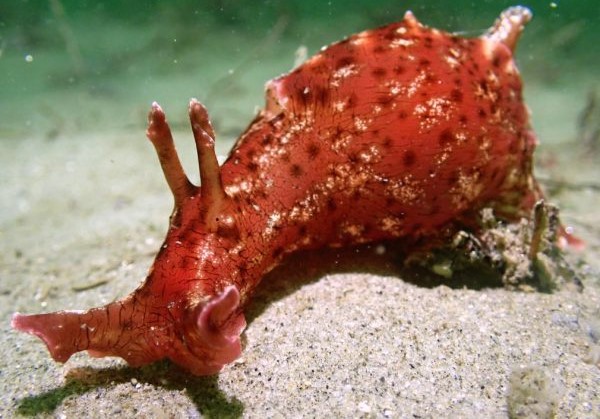
The La Jolla-based Scripps Institution of Oceanography is no stranger to getting calls from the public with questions about marine species found along local shores. Some callers wonder what something is; others think they’ve discovered a new species.
Once every month or so, Charlotte Seid, manager of the Benthic Invertebrate Collection at Scripps Oceanography, gets a call that starts with “I’ve lived here for 20 years and have never seen anything like what I just saw.”
Related Articles
Visiting Alcatraz? These dazzling birds are worth the price of admission
Meth, spider monkey, rattlesnakes seized after Bay Area traffic stop, home search
When can coyotes be killed in California? Proposed change sparks furor
Why a contentious project to raise California’s Shasta Dam could move forward under Trump
Exploring the Farallon Islands’ wildlife haven
More often than not, Seid said, the caller is referring to a type of sea slug called the sea hare that has washed onto the beach.
“It’s the one everyone seems to ask about,” Seid said with a laugh.
Sea hares are not harmful, she added, but “can be terrifying when they wash up and people don’t know what they are.”
Sea hares, similar to garden slugs but much larger, can be found off the La Jolla coast and in tide pools. They migrate only to find algae or seagrass to eat. The types found in La Jolla include the California sea hare and black sea hare.
The California sea hare is commonly 6-12 inches long, but the black sea hare can be the size of a small cat, Seid said. Both have a slimy, soft body and protrusions that look like rabbit ears.
The black sea hare can be the size of a cat. (Charlotte Seid)
“They are large and puzzling, but many might escape your notice,” Seid said. “It’s right to be curious. If you see a crab claw, you know what that is. But these slugs can look really weird … and many are larger than any one you might see on land.”
The black sea hare has a dark exterior with no markings.
The California sea hare usually is reddish with spots. The babies can be found in tide pools and often are bright red, though they get a more subdued color as they age.
“If you look closely, they have these tiny beady little eyes,” Seid said. “It doesn’t have great vision, just the ability to see light and dark, but they have these little eyes that look like googly eyes that I think are adorable.”
Sea hares are slow-moving and not strong swimmers, “so sometimes they find themselves banged up by the surf or washed onto shore,” Seid said.
If a beach-goer finds one out of the water that appears to be alive, “gently get it back into deeper water, but do not harm yourself in the process,” Seid said.
A sea hare’s only defense is to release a bright magenta ink. Though harmless to humans — except for the possibility of staining one’s skin or clothes — is it a deterrent against its main predator, the spiny lobster.
The sea hare’s only other predator is a larger type of sea slug.
“If you are curious and feel safe in the tide pools, it is generally safe to hold [a sea hare] gently,” Seid said. “I have gently scooped them up, but don’t expose them to the air for too long.
“If you have a camera, that can be fun, too, to see their textures. They are slimy, so don’t be shocked and drop them. And put it back where you found it. If it’s in shallow water, you can give it a boost.”
A California sea hare is commonly 6-12 inches long and reddish with spots. (Charlotte Seid)
The sea hare, which is not considered threatened, reproduces in what Seid called a “conga line” process.
“Every sea hare is capable of being male and female, so when they reproduce, they form a line and share material,” she said. “Then they lay eggs, and larvae hatch. Then the larvae go into the currents, but not too far, and will often attach to seagrass for them to eat and grow.”
Though it’s a “very humble creature,” the California sea hare has achieved some notoriety for its role in a Nobel Prize-winning study.
Using the animal as a model organism to study short- and long-term memory, Eric Kandel won the Nobel in physiology or medicine in 2000.
Kandel, who studied how memories are stored by nerve cells, “found that as the [sea hare] learned, chemical signals changed the structure of the connections between cells, known as synapses, where the signals are sent and received,” according to the Nobel organization. “He went on to show that short-term and long-term memories are formed by different signals. This is true in all animals that learn, from mollusks to man.”
The sea hare “helped humanity learn about our own brains and how our neurological cells work. They’re pretty cool,” Seid said.